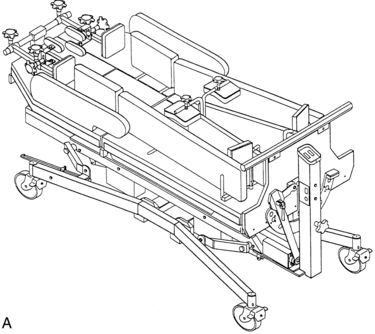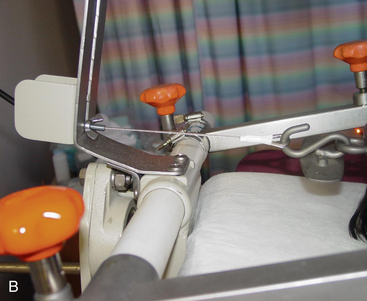PROCEDURE 100 • Knowledge of neuroanatomy and physiology is necessary. • The nurse needs to be knowledgeable about the anatomy and physiology of the spinal column, the special anatomy of the cervical vertebrae, the spinal cord, the cervical spinal nerves, and their areas of innervation. In addition, the nurse must understand the pathophysiology and manifestations of spinal cord trauma, including spinal shock, ascending edema, and related impairment of respiratory function, decreased vasomotor tone, and autonomic nervous system dysfunction.1,2,10 • The nurse needs to be knowledgeable about the signs and symptoms of new spinal cord injury or extension of injury and the needed interventions. • After the cervical tongs are inserted, traction is applied by adding weights to a rope and pulley or cable and bracket alignment device attached to the tongs (see Fig. 97-1). Additional weight may be added gradually, followed with radiographic imaging. The physician uses serial radiographs of the cervical spine to assist in determining the optimal amount of traction (measured in pounds) needed to reduce a fracture and provide optimal alignment. Excessive traction may cause stretching of and damage to the spinal cord; the addition of weight to the traction is managed by the physician.3,9 • Once the traction is in place, the patient is maintained on strict bed rest. For facilitation of turning, the patient may be placed on a special bed or turning frame (Fig. 100-1). • The principles of skeletal traction are the foundation of management of any patient in cervical traction. One must follow such key points as (1) never raising the traction weights, (2) never disconnecting the traction, (3) never allowing the traction weights to rest on the floor, and (4) never allowing other objects to compromise freely hanging weights. • Cervical traction system in place, including rope and pulley system or cable and bracket alignment device and weights for the Rotating Kinetic Treatment Table (Roto-kinetic) (Fig. 100-1) or RotoRest™ Delta Kinetic™ Therapy Bed (Fig 123-1).
Cervical Traction Maintenance
PREREQUISITE NURSING KNOWLEDGE
EQUIPMENT
![]()
Stay updated, free articles. Join our Telegram channel

Full access? Get Clinical Tree


100: Cervical Traction Maintenance


